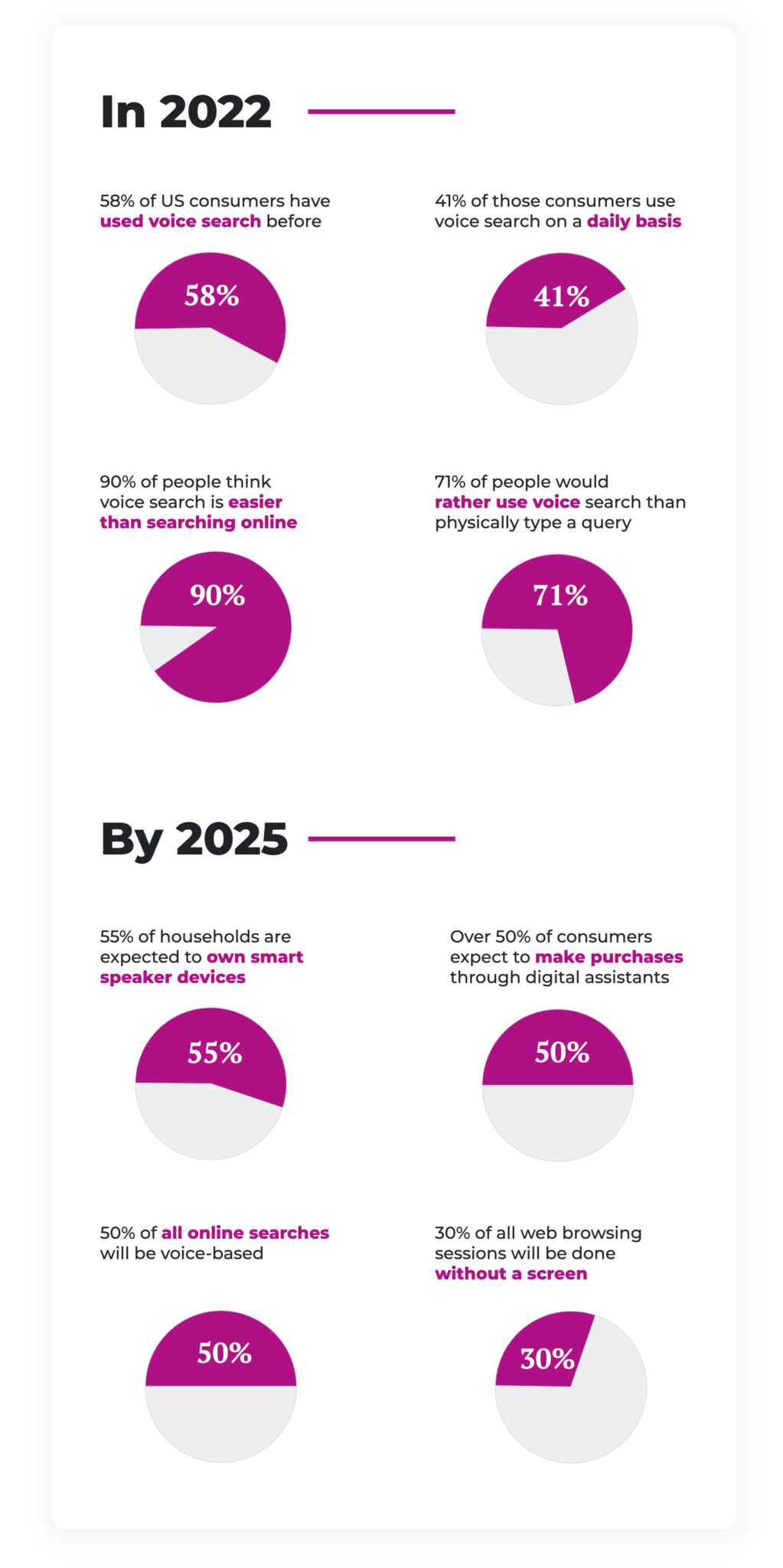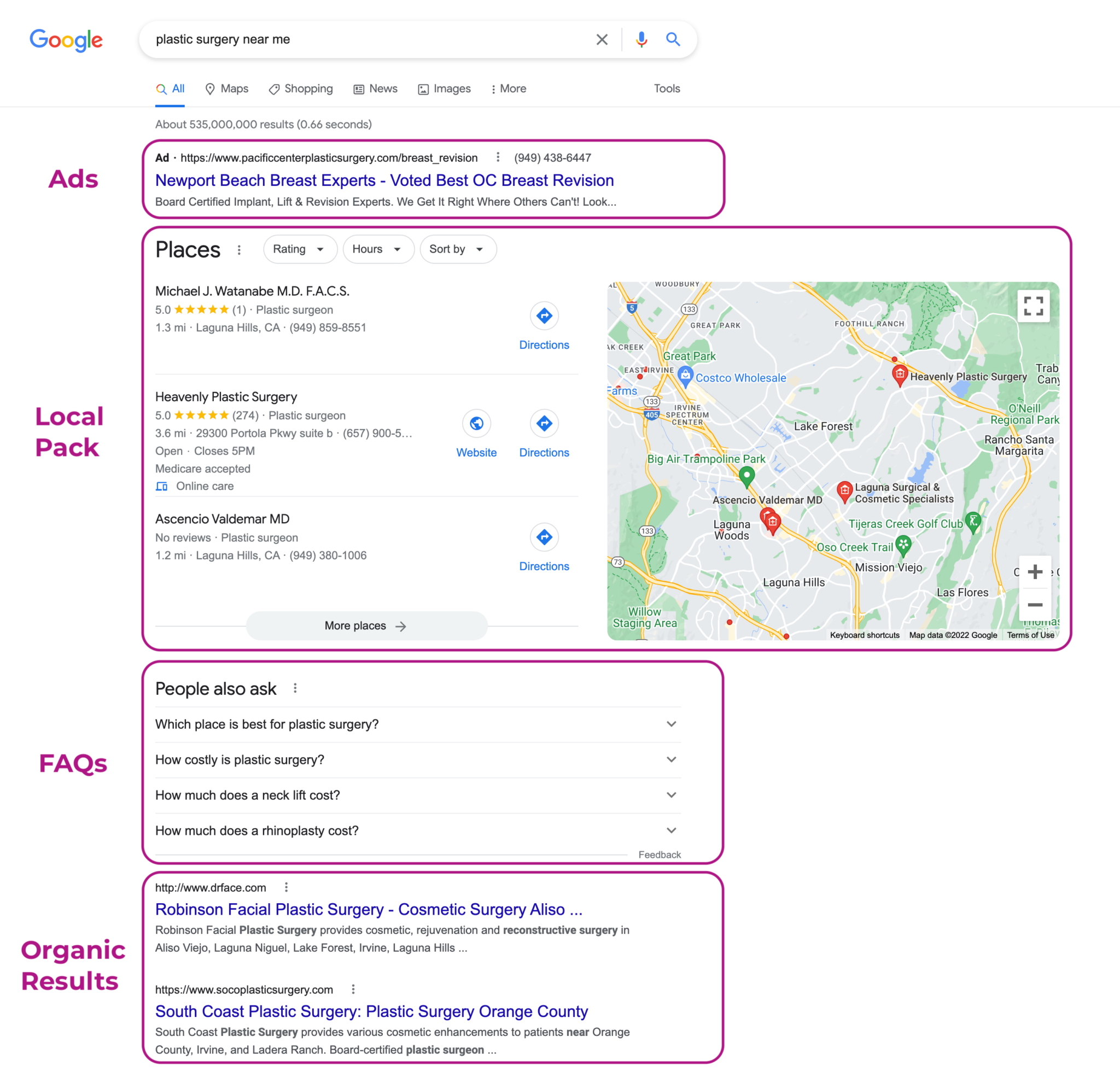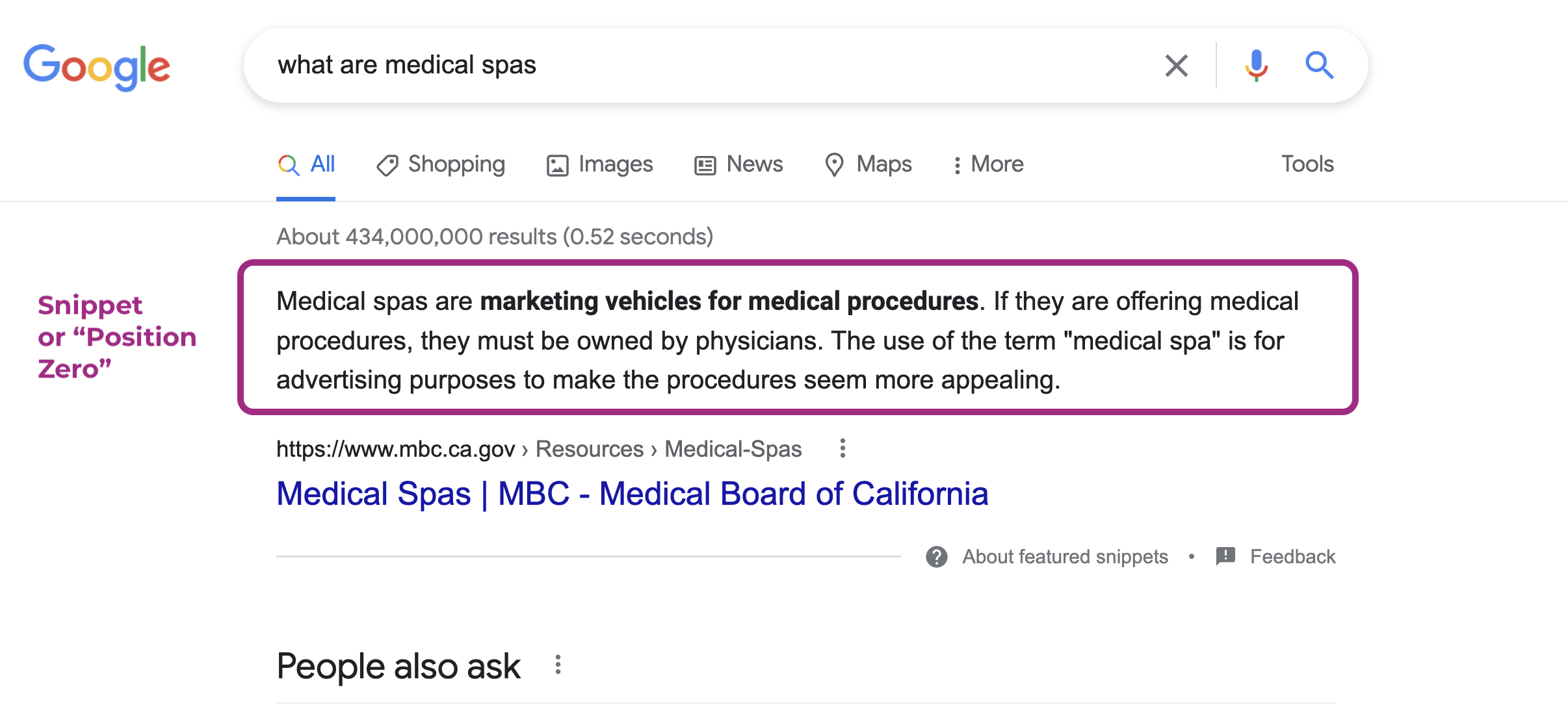7 Ways to Optimize Your Medical Website for Voice Search
Artificial Intelligence is booming in 2022, helping anyone with an internet connection find information without ever lifting a finger. Siri, Alexa, Cortana, Google Home and Amazon Echo are among the most popular voice command entities that have transformed the way people receive information. But how do you position your practice to be a leader in voice search results?
Optimizing voice search results requires creating smart content that responds to inquiries that begin with who, what, when, where, why and how. Conversational language is at the core of voice command AI since the average person will be asking questions in natural language.
If your practice isn’t producing voice search results, you are losing ground to competitors who are already optimized for the next generation of SEO. This article examines SEO in AI and how to optimize your practice’s rankings in voice commands.
We’ll dive into voice-search SEO to show you how to optimize your medical practice’s website for voice search queries in AI.
Our strategy will guide you in implementing smart, responsive content to natural language that will help you attract new patients, develop more conversions in your practice, and implement location technology to attract nearby potential customers, and more.
“Hey Siri, How Does AI Power Voice Search?”
Artificial intelligence is the primary source powering voice search engines, and it becomes smarter with every conversation. Forget about searching through pages of results, opening new tabs, or making phone calls. Patients can have a real-time conversation with a virtual assistant to find out details about your medical practice.
So how do we make sure the AI robots are happy? (It’s a trick question, they have no souls… yet)

A mixture of AI and algorithmic automation helps develop speech systems. Voice AI is based on understanding human language and making interpretations to offer appropriate results. It then perfects its algorithms to always provide the best rational answer.
So by understanding the way that AI works in answering voice-based questions, you’ll be able to better optimize your website and content to meet the needs of voice search’s ever-evolving algorithm. Seems like a lot of work, but is it worth it?
“Hey Cortana, Why Does AI Voice Search Even Matter?”
To answer this question, we’ll let the stats speak for themselves.

Statistics from various sources published on bloggingwizard.com
On top of the fact that voice search is becoming the dominant source of search over the coming years, it’s also important to note that voice search yields more robust results, which drive organic traffic. Typed results include a page of clickable options. Spoken results include names, locations, hours, star ratings, call buttons, etc.
Remember, you have one shot.

Voice assistants often give only one answer in response to a given query, so it’s important that all of your digital marketing is optimized to the highest possible standards of today’s search algorithms and how they are created to best meet the needs of today’s modern consumer and constructed for future consumer behavior. Right now, that future is voice search.
“Hey Alexa, How Do I Optimize My Website for Voice Search?”
1. Natural Language
Conversational language is one of the most important factors in voice search. Searches are a conversation with a virtual assistant because people ask full-sentence questions when they use voice search devices.
Think about how you would ask your voice assistant for information on a certain treatment, it would probably sound something like this:
“Hey Siri, what are the most common side effects of Botox injections?”
You would want to rework your writing to be more conversational, whether it be in your titles, headings, or body paragraphs. Here are some examples of good vs. poorly optimized content:
| Content Type | Bad Example | Good Example |
|---|---|---|
| Title | “Botox injections and their side effects” | “8 most common side effects of Botox injections” |
| Heading | “Botox injections side effects” | “Some of the most common side effects of Botox injections” |
| Paragraph | “..if you’re planning on getting Botox for the first time, think about the side effects. Here are some common ones…” | “...if you’re planning on getting Botox for the first time, you’d probably want to know what the most common side effects of Botox injections…” |
Longer tail keywords are becoming the new norm. Target keyword phrases that are 6-8 words long and written conversationally. Best practice would be to start by researching and strategizing the most commonly asked questions related to your topic and working that into your titles, headings, and body paragraphs in a natural, conversational manner.
2. Site Speed
The average page for voice search results loads in approximately 4.6 seconds. Not only do consumers have historically short attention spans, but voice users expect an instant response on voice searches so fast-loading sites are prioritized to provide the quickest responses to voice users.

Pages that rank for voice searches load 52% faster on average than non-ranking pages.
Here are some ways to optimize site speed:
- Optimize content size including images, videos, and graphics
- Remove unnecessary plugins and make sure that essential plugins are up-to-date
- Minimize HTTP requests and switch to HTTP/2
- Avoid redirects
- Reduce cookie size and eliminate unnecessary cookies
- Put the website’s JS and CSS in external files
- Implement zip compression
- Use a content delivery network (CDN)
- Code your website to be mobile-first
- Choose the right hosting service plan
There are other added benefits to faster site speeds that indirectly contribute to voice search optimization and are directly related to earning position zero on search (or snippets), more on that later. Shorter load times will also help your website achieve higher rankings because site speed is a direct factor in website authority. Also, faster loading pages lead to a lower bounce rate and higher conversions, and nothing else matters if you’re not converting visitors into prospects.
3. Authority and Page Quality
Domain authority is vital because there’s a consumer expectation that voice search results should be accurate. In fact, with voice search results, you have one shot. This means that the information in the results is expected to be the #1 most accurate result possible. How do you do that? By earning position zero on search, otherwise known as a featured snippet.

70% of voice search answers come from SERP features like featured snippets, so writing for E.A.T. is important.
But what does all this jargon mean?
What Are SERPs?
Search Engine Results Pages, (SERPs), are Google’s response to a search query. These tend to include organic results, paid ads, featured snippets, FAQs, video results, and more. In other words, when you type (or say) something to Google, the SERP is what you get back in return.

Here are some common SERP features you may see on Google:
-
- Featured Snippets
- Google Ads
- Local Pack (Google Business Page)
- Sitelinks
- Videos
- Top Stories
- Images
- Knowledge Panel
- FAQs
- People Also Ask
- Related Searches
- Job Listings
- Google Ads
- Shopping Ads (Product Listing Ads)
- Organic Results
What Is a Snippet?
Featured snippets are highlighted excerpts of text that appear at the top of a Google search results page, otherwise known as ‘Position 0’. They provide search users with the most relevant, quick answer to their search query. Featured snippets are used in a large majority of voice search results because, by nature, they are the best possible answer to a query that can be provided.

And remember, you only have one shot.
What Is E.A.T.?
Otherwise known as page quality, E.A.T. stands for Expertise, Authority, and Trust which are the three factors Google relies on to measure the trust it should place in a website or brand.
Let’s Break it Down:
Expertise
As a medical practice, it’s imperative that you be an expert in your field. Expertise means you need to show the skills for the Main Content (or MC) and make sure to mention it repeatedly in your content. This is less critical for gossip or humor websites, but it’s vital for medical websites. Your website can show its expertise if the content on the site is truthful and useful for users.
Authority
Just as you would with your patients in person, you need to show that you are an authority online as well. This comes largely from the expertise of your writer(s) and/or yourself. If the blog section on your medical website has a comment option, the quality of the conversation drives authority as well. Credentials are a necessity, but personal experiences like reviews are also extremely important to building authority.
Trust
It’s important to show your patients that they can trust your practice and the creator of the Main Content and the website. Trustworthiness is especially important if your medical practice sells products online and has an eCommerce page that asks users for their credit card information. Everything about your website should make visitors to your site feel safe. To start, you should immediately implement an “SSL certificate” on your website as it’s one of Google’s many (and more important) scoring signals.
Long-Form Content
Another factor in your website’s authority is the length of your content. Pages that rank for voice searches have an average word count of 2,312.
By providing high-quality (YMYL) long-form content on your website, you bring credibility to your practice. Eventually, this establishes your website as an authority in your industry or on a certain subject, which can ultimately lead to higher ranking search results for popular voice queries.
4. Local Information Optimization
One of the simplest and most important things you can do to optimize for voice search is ensure your NAP (Practice Name, Address, Phone number) are correct across all web presence.

58% of voice search users search for local business queries.
First and foremost, you want to optimize your Google Business Profile (formerly known as Google My Business). You want to make sure you claim and optimize all social media including Facebook, Instagram, Twitter, Yelp, RealSelf, and more. Also, comb through your online listings to correct mistakes: duplicate listings, inaccurate addresses and wrong hours.
Local SEO Optimization Tips:
-
- Include your region in content and metadata
- Create location-specific pages with more than just a footer address
- Use visuals specific to your local area with alt-text tags
- Tag images and videos with the name of the geographic area
- If videos and audio discuss a specific location, provide a transcript to boost the website’s accessibility
“Things Near Me”
People extensively use the search query for “things near me”. Try incorporating the following keywords into your SEO strategy:
-
- Phrases that describe the neighborhood around your location
- “Near me” in your title tags, meta description, and internet links
- Landmarks around your business location
- Patients who leave reviews with locations mentioned
Structured Data
Voice-powered services rely on structured data to provide rich results like hours, addresses, or photos. Ensure your website’s content and schema is structured in a way that these services understand.
5. Question-Based Content
Quite literally every voice search query is a question. Create other content to address users’ questions. This includes videos, blog posts, before and after photos, and FAQ’s.
By answering questions, not only are you able to optimize your content for natural language search, but you also encourage users to take steps toward conversion. Different types of questions signal different phases of the buyer’s journey. For example, “What” and “Who” questions signal that a user is in the research phase and “Where” questions signal they are almost ready to buy.
For the medical field specifically, patients will rely more heavily on their voice-enabled devices to answer questions about things like:
- Provider research
- Treatment options
- Locations close by
- Reviews
6. VUI (Voice User Interface)
Historically, a website’s UX banked on GUI (or Graphical User Interface) for visual interfaces. This is quickly being replaced by the VUI (Voice User Interface), which acts as a reciprocal interface between the command medium and the user.

- Design a more natural way of interaction – Similar to writing conversationally, you also need to design the UI to interact naturally with a voice-enabled product.
- Design for flow – Voice input is the first step of a task for many products that have voice-enabled interfaces and any subsequent tasks require the user to shift to touch interaction. Provide as much information as possible and encourage users to take the take next step:
- Contact information
- Links
- Calls to action
- Reviews
- Ratings
- Directions
- Links to social media
- Question & answers
- Use sequential numbering for search results – Most voice queries produce a single definitive result. But when you have more than one result, it’s good practice to assign a number for each result. The numbers will provide verbal ‘handles’ that let users efficiently select items.
- Minimize typing operations – Hands-free interaction is the main benefit of using voice search because speaking a command aloud is more frictionless than typing it. Thus, voice users are trying to avoid taking traditional input steps to convert.
- Have knowledge of the context – Voice searches are three times more likely to be local-based than normal text searches. This means that by searching locally, they are that much more likely to use a voice UI. It’s important to consider information like location and time of the day when delivering results.
7. Mobile
When you think of voice search, you probably tend to think of devices such as Alexa and Google Home, but 27% of the global online population uses voice search on their mobile devices.

Voice search enables users to ask hyper-local questions on mobile devices anywhere, anytime, and without lifting a finger. Okay, maybe they have to tap a time or two, but you get the point.
Make sure things like directions to brick-and-mortar locations and XML sitemaps are readable to visitors and search engines on your website.
“Hey Google, Give Me Directions to Success”
Successfully optimizing SEO voice search will ultimately lead to more patient conversions and inquiries. Your voice-command SEO strategy coupled with smart content will help your practice gain more conversions over time compared to focusing solely on a traditional SEO strategy.
It’s 2022, if your medical marketing strategy doesn’t include a voice-search optimization component, you’re preparing for failure. If you follow the steps we’ve outlined and create an AI strategy for your medical practice, you will not only attract new patients but also become a leader in your industry and stand apart from your competitors.
If you feel like you need more information or want to learn more about how to optimize your medical website for voice search, our educators are here to answer any questions you have, anytime, for free. Give us a call at (800) 949-0133 or schedule a one-on-one.




